Review: #42179 Planet Earth and Moon in Orbit (LEGO Technic)
I’ve always wanted to play with an interactive model of the Sun, Earth, and Moon — and had the first chance by building this extremely unique LEGO Technic set.
First Impressions
When I first saw some of the spring 2024 releases, #42179 Planet Earth and Moon in Orbit immeditately caught my imagination! I absolutely love the idea of playing with an Orrery to see how the Earth rotates around the Sun, but have never had the chance to play with one. The idea of building one using LEGO Technic pieces is very compelling. I am especially curious to see how close to the real 365-day rotation this model is able to achieve using existing parts. I’m also curious to see if it can be easily motorized.
Box Contents
My copy included paper bags, which is becoming increasingly common this year, especially for sets produced in Europe. (Pre-review sets are almost always produced in Europe, even though I am located in North America.)
- Box Size: 38 × 25.9 × 9.2 cm (15 × 10 1/4 × 3 5/8”)
- Box Weight: 1022 g (2.3 lbs)
- Part Count: 526 pieces
- LEGO Parts Weight: 551.2 g (1.21 lbs)
- Weight-per-piece: 1.05 g/piece
- Price per piece: $0.143 per piece
- Price per gram: $0.136 per gram.
- Numbered bags/stages: 4
- Pieces per stage (average): 132 pieces.

Box contains 4 numbered bags, an un-numbered bag, some loose parts, instruction booklet and stickers.
- Bag 1: 1x extra-large paper bag (26×23 cm) marked 6488955 / 349S3.
- Bag 2: 1x large paper bag (23×21 cm) marked 6488949 / 548S3.
- Bag 3: 1x large paper bag (26×20 cm) marked 6488953 / 449S3.
- Bag 4: 1x large paper bag (26×19 cm) marked 6488947 / 548S3.
- 1x large un-numbered plastic bag containing:
- 2x printed earth hemispheres (with Northern and Southern Hemisphere printing)
- 2x Ø11 Frame, Round (Part 77107) in 199Dark Stone GreyDark Bluish Gray
- 4x 56mm D. × 14mm Technic Wheel w/ Tire, Axle (Part 39367) in 26Black.
- 1x large un-numbered plastic bag containing:
- 2x Ø11 Hemispheres (part 4413) in 191Flame Yellowish OrangeBright Light Orange
- 2x Ø15 Frame, Round (Part 3250) in the new 402Reddish Orange color.
- 1x large 144-page instruction booklet with glued spine. 27.0 x 19.2 cm (10 5/8 x 7 5/8”).
Build Process
Bag 1 requires the four large Technic wheels and the first of the two Ø15 Round Frame parts. We begin by building a solid cross-shaped base that sits on the four wheels which are being used on their side for their skid-resistance instead of their ability to roll. The cross-shape is wobbly until we install four 11×11 35-Tooth ¼ Gear Ring (Part 24121).
After this, we build a rectangular sub-assembly containing gears, which is the first part of the complex mechanical systems that make this brick-built orrery work.
The Second Bag completes the base and lower mechanisms. This involves a number of additional gears to step down the rotation speed. This involves a sub-assembly containing additional gears that slides into place in the middle.
Near the end, we attach a crank to one side, which allows us to see how power from the crank is transfered pretty quickly to a central rotating axle (upon which I expect the sun will attach and rotate), as well as the very slow rotation of a 60-tooth Turntable on the top which I anticipate the armature suppoting the Earth will attach to. If ever there was a testament to my enthusiasm for this set, I actually applied the stickers labeling each month to the reddish-orange ring. I hate stickers but concede that they are appropriate in this context.
Continuing to Bag 3, it is time to build another complex gearbox and the armature where the Earth and Moon will eventually be attached. I was surprised by how much additional gearing is included within the armature, which we learn at the end of this bag causes not only the earth and moon to spin, but also for the sun itself to spin.
We attach the armature, followed by two more curved white panels on the sides that are also used to strengthen the model. Finally, we add the sun itself to the top of the model in the final step.
This leaves just one more bag to complete the model. Bag 4 is all about a final sub-assembly which we will attach to the armature from the following bag. This one is pretty complex as well, with mutiple gear ratios employed to allow the earth to rotate very quickly on it’s axis while the moon rotates quite slowly around the earth. We have another ring with stickers showing the phases of the moon, and another pearl gold part pointing to the current phase.
After attaching it, there’s just a few steps remaining to strengthen the connection, and it’s play time! It is an absolute joy to use it for the first time, with each crank of the lever causing the earth to rotate several times, while the moon rotates slowly around the earth and the sun rotating on it’s own axis at about the same speed as the moon.
Build time: 81 minutes. (Bag 1: 18 minutes, Bag 2: 18 minutes, Bag 3: 18 minutes, Bag 4: 27 minutes. Build time does not include the time to apply stickers)
Value
Value is complicated to assess, so I’ll offer just two ways of thinking about value with this set. On the first hand, there’s the learning value of this set which is very high. Even just a very cusory online search shows that you can get a pre-built Sun and Moon Orbit model for about 40$ on Amazon. I would argue that the additional learning opportunities associated with actually building the model are worth the higher price.
| LEGO Set | Price | Part Count | Price-per-part | Weight | Price-per-gram |
|---|---|---|---|---|---|
| #31203 World Map | $249.99 | 11,695 pieces | $0.021 per-piece | 4020 grams | $0.062 per-gram |
| #21056 Taj Mahal | $119.99 | 2022 pieces | $0.059 per-piece | 1811 grams | $0.066 per-gram |
| #21058 Great Pyramid of Giza | $129.99 | 1476 pieces | $0.088 per-piece | 1832 grams | $0.071 per-gram |
| #10278 Police Station | $199.99 | 2923 pieces | $0.068 per-piece | 2602 grams | $0.077 per-gram |
| #71799 Ninjago City Markets | $369.99 | 6163 pieces | $0.06 per piece | 4770 grams | $0.078 per-gram |
| #71741 Ninjago City Gardens | $299.99 | 5685 pieces | $0.052 per piece | 3719 grams | $0.081 per-gram |
| #71043 Hogwarts Castle | $399.99 | 6020 pieces | $0.066 per-piece | 4899 grams | $0.082 per-gram |
| #10292 Friends – The Apartments | $149.99 | 2048 pieces | $0.073 per-piece | 1778 grams | $0.084 per-gram |
| #10297 Boutique Hotel | $199.99 | 3066 pieces | $0.065 per-piece | 2380 grams | $0.084 per-gram |
| #21343 Viking Village | $129.99 | 2103 pieces | $0.062 per piece | 1448 grams | $0.090 per-gram |
| #42639 Andrea’s Modern Mansion | $199.99 | 2275 pieces | $0.088 per piece | 2116 grams | $0.095 per-gram |
| #10312 Jazz Club | $229.99 | 2899 pieces | $0.079 per-piece | 2392 grams | $0.096 per-gram |
| #10270 Bookshop | $199.99 | 2504 pieces | $0.080 per-piece | 2085 grams | $0.096 per-gram |
| #10332 Medieval Town Square | $229.99 | 3304 pieces | $0.0696 per piece | 2249 grams | $0.102 per-gram |
| #10282 Adidas Originals Superstar | $79.99 | 731 pieces | $0.109 per-piece | 735 grams | $0.109 per-gram |
| #10316 Rivendell | $499.99 | 6167 pieces | $0.081 per piece | 4375 grams | $0.114 per-gram |
| #10305 Lion Knights’ Castle | $399.99 | 4514 pieces | $0.089 per piece | 3265 grams | $0.122 per-gram |
| #10303 Loop Coaster | $399.99 | 3756 pieces | $0.106 per-piece | 3189 grams | $0.125 per-gram |
| #42179 Planet Earth and Moon in Orbit (this set) | $74.99 | 526 pieces | $0.143 per piece | 551 grams | $0.136 per-gram |
| #75290 Mos Eisley Cantina | $399.99 | 3187 pieces | $0.126 per piece | 2521 grams | $0.158 per-gram |
As for our more objective measures of value such as price-per-part and price-per-gram, this set is atrocious. It has the second worst price-per-gram that we have measured and a comparably poor 14.3 cents per part.
Conclusion
This set is just one of eight LEGO Technic sets that are being released on March 1, 2024. We just received a huge stack of these sets and will review as many as we can in the weeks to come!
March 2024 LEGO Technic Lineup:
- #42179 Planet Earth and Moon in Orbit (This set)
526 pieces, ages 10+, $75, available March 1 at LEGO.com - #42180 Mars Crew Exploration Rover
1599 pieces, ages 11+, $150, available March 1 at LEGO.com - #42181 VTOL Heavy Cargo Spaceship LT81
1365 pieces, ages 10+, $110, available March 1 at LEGO.com - #42178 Surface Space Loader LT78
435 pieces, ages 8+, $35, available March 1 at LEGO.com - #42171 Mercedes-AMG F1 W14 E Performance
1642 pieces, ages 18+, $219, available March 1 at LEGO.com - #42165 Mercedes-AMG F1 W14 E Performance Pull-Back
240 pieces, ages 7+, $27, available March 1 at LEGO.com - #42169 NEOM McLaren Formula E Race Car
452 pieces, ages 9+, $50, available March 1 at LEGO.com - #42170 Kawasaki Ninja H2R Motorcycle
643 pieces, ages 10+, $85, available March 1 at LEGO.com
While I have not built them all yet, I feel comfortable saying that this set will be one of the best because it explores a completely new topic for an official LEGO Technic set. That’s because almost every LEGO Technic set is based on a vehicle of some kind — a pure mechanical machine is a really unusual offering in the theme. I think this is a great thing — this set has the potential to introduce a lot of new builders to LEGO Technic!
One lunar month is represented by about 26 rotations of the earth.
This is an excellent set which would earn our very highest marks if it weren’t for the issue of value. It unfortunately scores near the bottom of our rankings in both price-per-part (which I expected would be poor) as well as price-per-gram. This is our most objective way of measuring value in LEGO sets, and I can not give a perfect rating to a set that is so obviously overpriced.

It’s really helpful to have an interactive model when trying to understand the orbits of the Earth and the Moon.
Despite the poor value, #42179 Planet Earth and Moon in Orbit easily earns our Excellent (4/5 star) rating. If you can find it for 20% off, it’s a must have in my book.

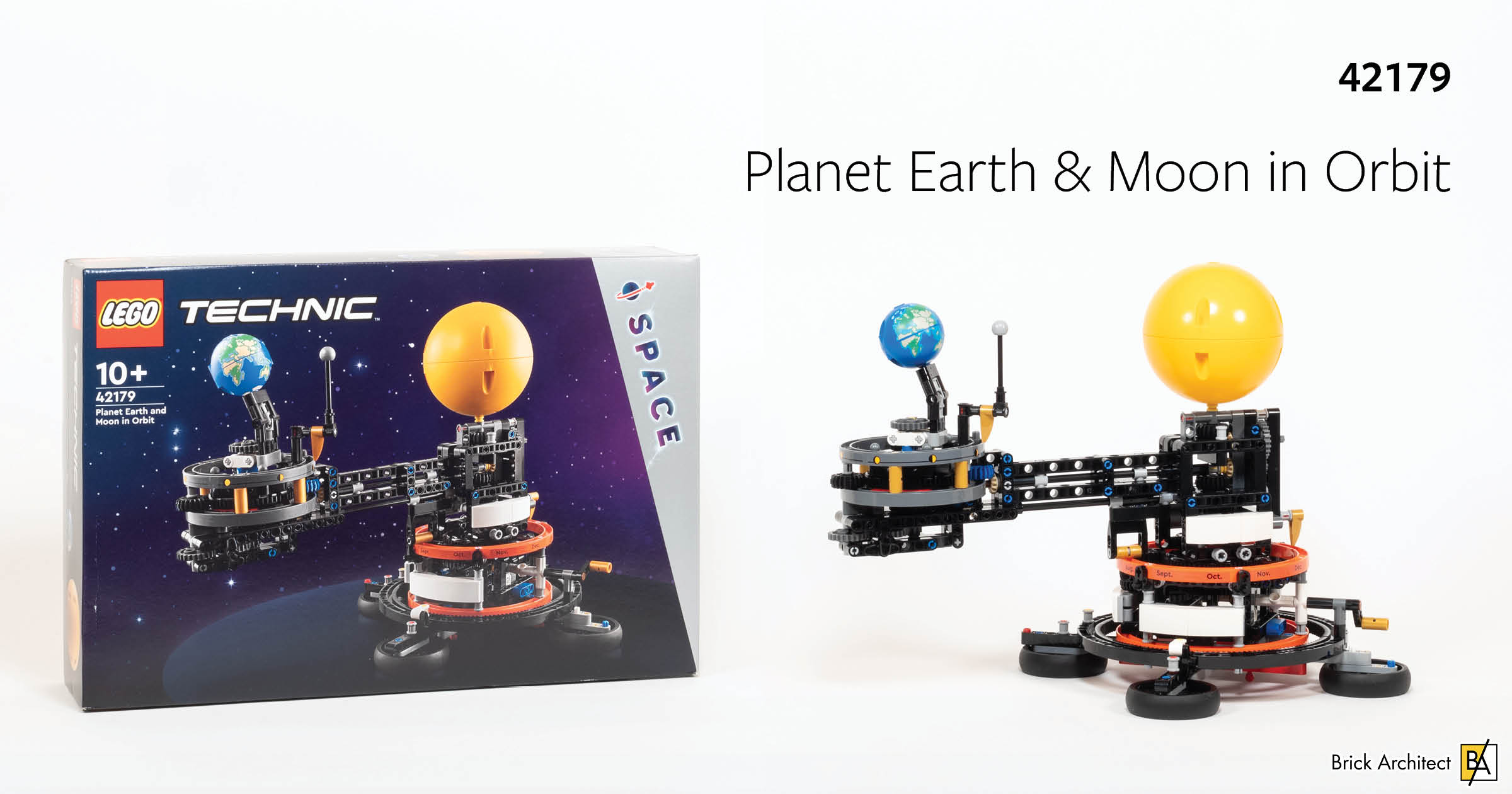

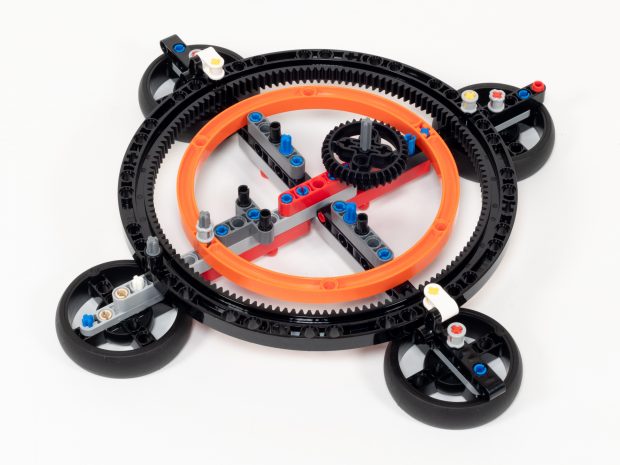
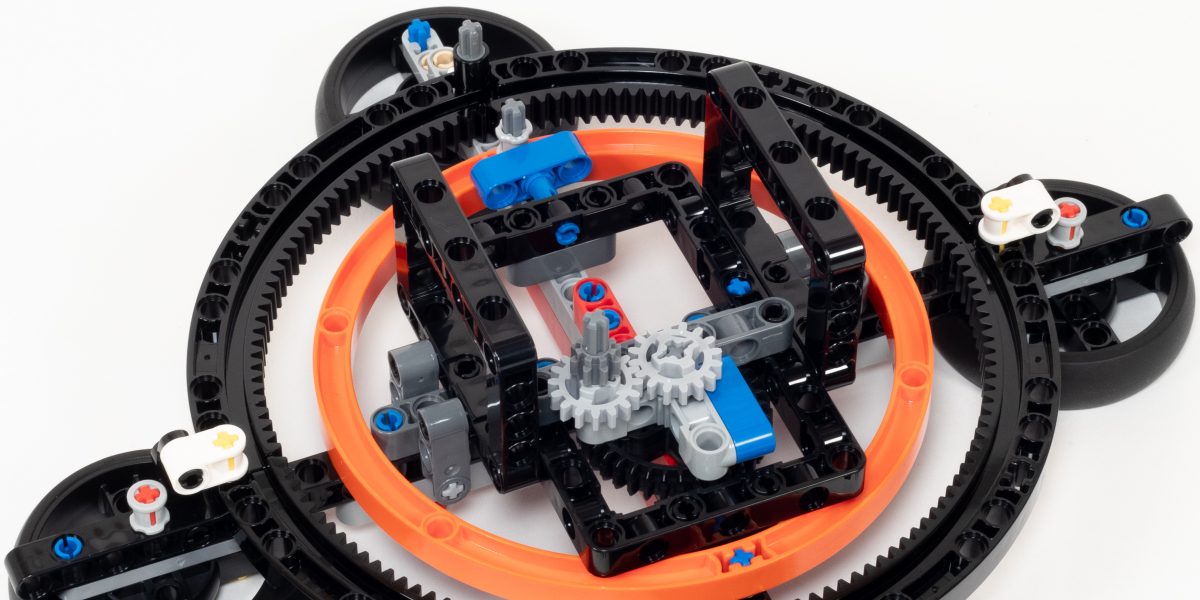
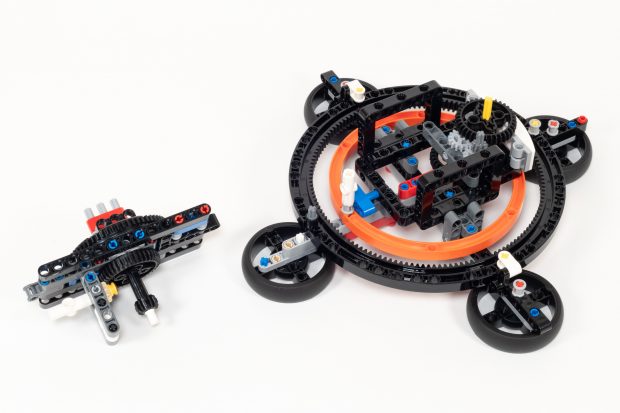


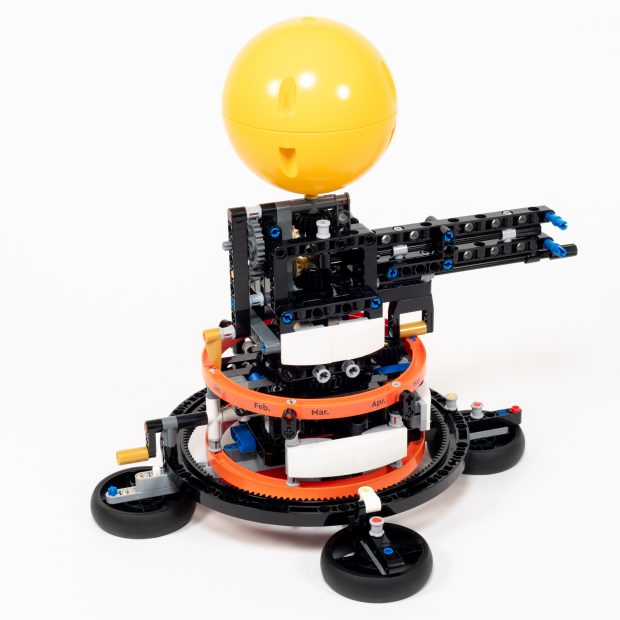
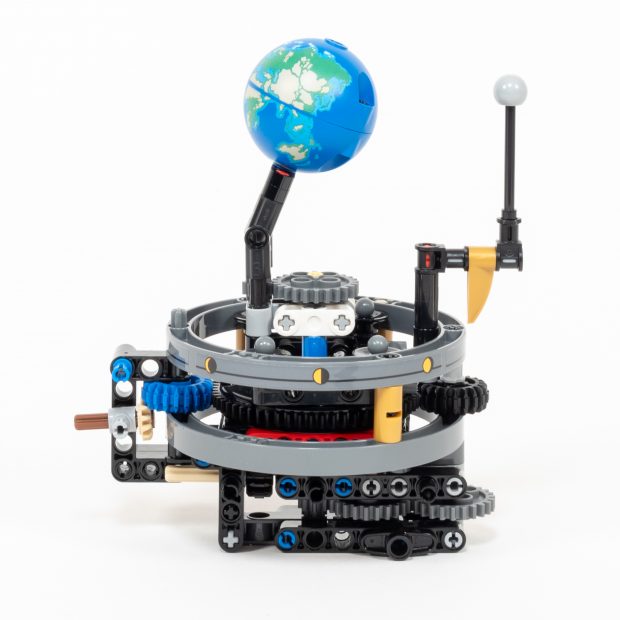
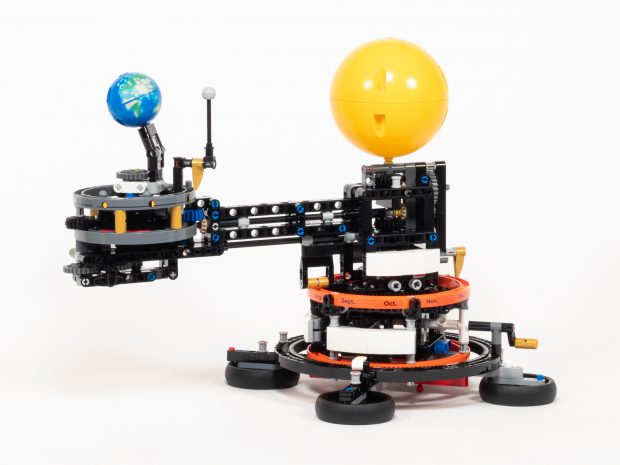
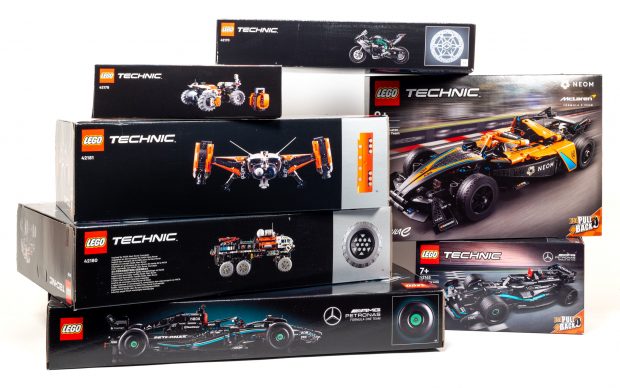
I hope the produce another version of this set where the planet is printed to actually represent Earth. Based on the gross geographic inaccuracies, I assume that this one was based on the maps drawn by the conquistadors.
Just finished building this set, and while I know the objective metrics tag it as overpriced, subjectively it is worth every penny. incredibly satisfying mechanism, and just a wonderfully unique set.
Curious…have you tried motorizing it as you hinted at in your intro? I will likely give it a shot soon, but wondered if you had done so yet.
Thank you for the review!
I did motorize it – the short video in the middle of the article was recorded with it attached it to a motor. I don’t remember, but I think I was using a Technic XL Motor at the slowest speed. It worked but was not completely smooth. I also tried a configuration using a worm gear to slow the motor down a lot, and it rotated very smoothly and slowly.
I’m curious to hear from others about their experiences adding a motor.
” I am especially curious to see how close to the real 365-day rotation this model is able to achieve using existing parts.” Did you get a chance to analyze this for it’s scientific accuracy? Very interested to know.
I counted a single month and tried to count a complete year. I believe it is 360 days, which makes sense since this is a relatively easy multiple to create using existing LEGO gears.
Apparently 360° in a circle is not a coincidence — the Babylonians used this number to represent their year, understanding as well that 360 is easy to divide into smaller whole numbers.
Hi Tom,
Thanks for another great review. At the risk of sounding pedantic, but in the interest of accuracy, an Earth Sun Moon Orbiter is called a Tellurion. An Orrery is a model solar system.
Not sure if this is the right forum to ask you about an ongoing defect that has existed in Legos products since, well forever – color stability. Anyone who has owned a number of Lego sets for any length of time will know that your model will deteriorate significantly over time. Light colored parts – White, Tan, LBG will inevitably fade or become discolored if exposed to UV. I am an AFOL living in Australia where we have a lot more UV in our atmosphere than Northern Hemisphere so this is a significant problem. Any new model I display can’t be in direct, or even indirect light. Despite all care taken, it will eventually deteriorate and lose its value. With all the r & d, new products and evolution of the Lego product it seem remiss they have not addressed what is a significant base defect in the whole product range that has always existed. Are Lego doing anything about this? I would for one prefer to see less new products until they fix this critical problem.
Cheers,
John
John, thank you for explaining that I used the wrong terminology – I will do a little more research and update the article when I have some time!
As for color stability and fading, this is a well documented issue. Beyond the issue of colors fading, especially when exposed to UV light, there are also known issues in color consistency, especially with Dark Red. Even Lime Green has had an issue with color consistency, although we learned the issue had more to do with the design of certain LEGO moulds causing the plastic to get too hot and discolor. (Learn more in this article: https://brickarchitect.com/2020/lego-house-virtual-fan-day/ )
Sincerely,
—Tom
All the colour trouble started during the brief period of outsourcing molding to Flextronics around 2007, who introduced the new process injecting the colour at the last moment instead of buying pre-coloured ABS.
LEGO took back production from Flextronics after only 2 years, but kept the process. The company motto is still “Only the best is good enough” yet they have no problem selling white bricks that are yellow within a few years and 50 shades of lime…
Could you guys please add a part list at the end of the manual
Yes, you will find a part list at the end of the manual. Now that the set has been released, you should be able to find a PDF that you can download at LEGO.com website.